How to Xeriscape on a Budget for an Eco-Friendly Yard

Create a Sustainable Yard With Xeriscape Landscaping
As summer comes along, so does the heat — and the need to conserve water, especially during drought season. Looking for more sustainable landscaping options for your yard? Xeriscape landscaping is a great way to create a unique yard while keeping your water use low. Learn how to xeriscape your yard with the following guide.
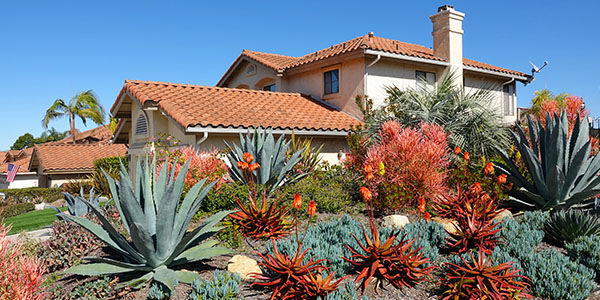
What Is Xeriscaping?
Xeriscaping is a drought tolerant landscaping method. Denver Water coined the term xeriscape, which means “dry-scaping.” The idea of xeriscape landscaping is to use as little water as possible to maintain your yard. Xeriscaping is very popular in drought-prone areas, but it’s a practice that you can incorporate into any yard.
There are many benefits of xeriscaping, both for you and the environment.
- By switching to dry landscaping, you can cut your irrigation needs by 50%.
- Installing efficient irrigation, using mulch and incorporating drought-tolerant plants all reduce water usage for your yard.
- Plus, when you replace your lawn with turf alternatives, you can increase your return on investment (ROI) by 10-15%.
- Xeriscaping is a low-maintenance way to keep your yard looking beautiful. Spend less time mowing and watering and spend more time enjoying your outdoor spaces!
- And you’ll help local wildlife by planting more native plants in your area.

“Water is a finite resource, and conserving it helps preserve our natural ecosystems. By reducing water usage, we can maintain healthy aquatic habitats, protect wildlife and sustain biodiversity. Climate change is affecting water availability and distribution patterns. Conserving water helps mitigate the impacts of climate change by reducing strain on water resources and promoting resilience in the face of changing weather patterns.”
Liesel Hans, Ph.D., Director of Programs, Alliance for Water Efficiency
7 Principles of Xeriscaping
So, how does xeriscaping work? Every xeriscape landscape uses the least amount of water possible. Denver Water created seven principles to follow to conserve water and make a sustainable yard. If you’re incorporating xeriscape ideas in your yard, it’s important to follow these seven principles to create a truly eco-friendly landscape.
1. Planning and design
It’s important to draw a plan for your design before beginning your project to identify different elements and zones in your yard.
2. Soil improvements
You may need to add organic compost and mulch to your soil to help it retain water better and drain quickly. Test your soil’s pH levels to see what additions it needs.
3. Efficient irrigation
You can water by hand or use an irrigation system. Be sure your water use is low and efficient. Water your plants’ roots and avoid watering during the day when the sun will evaporate water before it gets to your plants.
4. Plant zones
Group together plants that need the same amount of water and sunlight.
5. Mulches
Use organic and inorganic mulches in your landscape. Organic mulches include wood chips and compost, while inorganic mulches include rocks and gravel. Both types of mulches prevent water evaporation and reduce weed growth.
6. Turf alternatives
Non-native grasses use lots of water to stay green and healthy. If you want open spaces in your yard, consider covering the ground in clover, buffalo grass or other native, low-water use plants.
7. Maintenance
Xeriscape yards are low maintenance, but you need to do a few things throughout the year, like weeding and maintaining your mulch.
Not sure what to do with your yard debris? Check out our Yard Waste Guide!
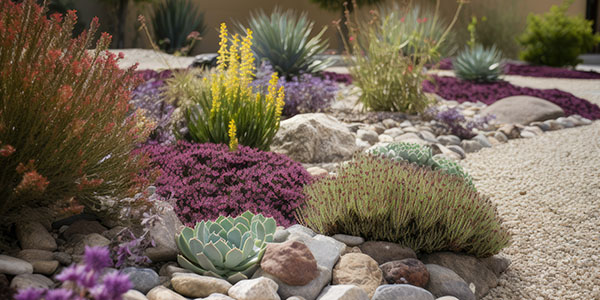
Who Benefits From Xeriscaping?
Residents in states like California, Arizona, Nevada and Colorado can benefit the most from xeriscaping, particularly from July to September when drought season is at its highest. By using dry landscaping, you’ll help conserve water that can be used where it’s needed most.
No matter where you live, it’s always a good idea to conserve natural resources. Only 2.5% of the water on Earth is fresh, and only about half of that is usable. Lowering your water usage means less water going through your local treatment plant and a lower water bill. So by using drought tolerant landscaping, not only are you saving the environment, you’re saving money too.

“By conserving water, we can
- Reduce the volume of water that needs to be treated, thereby lowering the energy demand associated with water treatment plants.
- Decrease the amount of energy needed to pump and distribute water through the network of pipes and infrastructure.
- Lower energy consumption and, consequently, energy utility bills.
- Reduce the energy needed for treating and managing wastewater.”
Liesel Hans, Ph.D., Director of Programs, Alliance for Water Efficiency
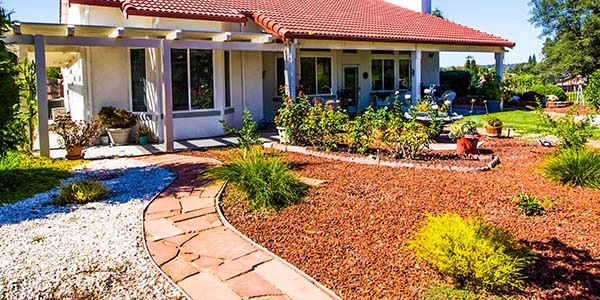
How Much Does Xeriscaping Cost?
If you’re working with a professional, xeriscape landscaping costs about $5 to $20 per square foot. This averages to about $17,000 for a 1,200-square-foot yard and $6,000 for a 500-square-foot yard. While xeriscaping your yard can be expensive upfront, it saves you money in the long run and it is DIY-friendly. If you choose to go the DIY route instead of hiring a professional, you’ll spend way less for your new landscape.
How to Xeriscape on a Budget
For a more budget-friendly landscaping project, consider the following tips.
- Design your new backyard yourself.
- Do the physical labor yourself — and rope in some friends to help.
- Rather than buying all new plants, buy seeds and plant cuttings, and choose plants that spread quickly.
- Avoid buying new concrete slabs and boulders by using more cost-effective elements, like shells and pebbles.
- Instead of buying new mulch, make your own.
- Only xeriscape a part of your yard. If you have a small front yard, or you’re looking for drought tolerant garden ideas, use this guide to create a mini xeriscape area at your home.
Apply for a Turf Replacement Rebate
Some states, like California and Colorado, will pay you to replace your lawn with xeriscape landscaping. If you live in a drought-stricken area, reach out to your local government to see if they have a turf replacement program you can participate in and save some money on your sustainable yard improvements.

“For single-family properties, Denver Water intends to participate in the nonfunctional turf replacement program resulting from House Bill 22-1151. We are examining ways customers can replace nonfunctional turf grass with water-wise landscapes that are better suited for our warming climate.”
Greg Fisher, Manager of Demand Planning, Denver Water
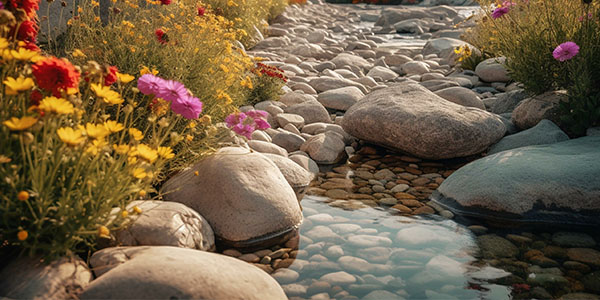
How to Xeriscape Your Yard
By following the seven principles of xeriscaping and our step-by-step guide, you can easily plan and create your ideal drought tolerant landscape on any budget.
1. Make a Plan
Start by drawing a map of your yard on graph paper, marking existing trees, patios and decks. Be sure to measure the square footage of your yard so you know how much material you’ll need for each zone you create. Decide which plants you want to keep and which areas you plan to recreate.
Find the Sunny and Shady Areas in Your Yard
Pay attention to the sun’s journey in your yard. Which areas are in full sun for most of the day? Which areas are mostly shady? Mark which times of the day the sun hits each area of your yard, so you can plan which plants to use.
Plan Your Zones
While noting the sunny and shady areas, identify the three zones listed below for your new landscape. A xeriscape landscape includes each of these zones, so you can group like plants and plan for water runoff and irrigation.
Zone | Description |
|---|---|
Oasis | This is the shadiest area, where you’ll keep plants that need the most water. |
Transition | These areas will have the most runoff water and are typically along walkways and fences. |
Xeric | This is the sunniest area of your yard, where you’ll keep plants that need the least amount of water. |
Find a Convenient Disposal Solution
Before you jump into your new dry landscaping project, rent a roll off dumpster for easy yard waste removal. You may need to dispose of rocks or get rid of dirt or existing grass and plants before beginning your project.
2. Prepare Your Soil
Your soil is one of the most important pieces to creating a successful xeriscape landscape. The right soil keeps your plants cool and conserves water by retaining just enough moisture for your plants to live.
Regrade Your Yard
If water pools around your house, walkways or driveway, you’ll want to regrade your yard to prevent yard drainage problems. Make sure your yard slopes away from your home, so water doesn’t pool near your house. You may want to rent a tiller to soften the soil so it’s easier to work with.
Measure the slope of your yard with stakes, string and a level. Fill in the uneven areas with soil, and be sure to keep with your desired slope measurement as you go. By regrading your yard, you’ll help direct the water to your plants that need it most and prevent the water from pooling or leaving your yard.
Test Your Soil
It’s important that you have the right soil so your plants and turf alternative can thrive. Test your soil’s pH levels before xeriscaping your yard. A neutral pH level is 7. Higher than 7 is alkaline and lower than 7 is acidic. Typically, plants grow best in soil with pH levels between 6 and 7, but some plants differ.
Check the desired pH levels of plants you plan to use in your yard to make sure you have the right soil conditions.
- To increase pH levels, add limestone to your soil.
- To decrease pH levels, add sulfur.
Soils with clay or organic matter are more resistant to pH level changes, so it’s important to add these elements to your soil if they are not already there.
Add Your Mulch
To help with water retention, mix in compost or organic mulch about 2-3 inches deep in your soil. Keep the mulch away from the base of the plants, and make sure not to pack the mulch too tightly. To help xeriscape on a budget, create your own mulch.

“Apply mulch to your garden beds to retain moisture, suppress weed growth, and reduce evaporation, which can help conserve water.”
Liesel Hans, Ph.D., Director of Programs, Alliance for Water Efficiency
Mulch doesn’t need too much maintenance throughout the year. To keep your mulch fresh, turn and mix it at the start of each season. If you’re adding new mulch to your yard, be sure to remove the old mulch so you don’t have more than 2-3 inches of mulch. While mulch helps prevent weeds, some will still grow, so make sure to pull weeds when you see them.
3. Add a Walkway or Patio
Hard elements, like slate and rocks, reduce the amount of grass and soil needed for your yard, which means less water all around. Installing a paver patio on your own will help you create those hard elements without breaking the bank. But what material is best for your walkway or patio? Concrete seals the ground, preventing water from entering the soil, so avoid using it to make a patio or walkway. Slate pavers are a great option because they last longer. When installing your pavers, be sure to leave space in between each of them. This makes it easy for water to enter the soil and for small plants to grow.
4. Install Efficient Irrigation
Irrigation is one of the seven principles of xeriscaping for a few reasons. Irrigation helps keep your plants alive of course, but when done well, it can actually help you conserve water, too. There are a few ways to install efficient irrigation:
- Build a streambed with rocks to capture runoff and let the water sink into the soil.
- Build a rain barrel to catch rain to water your plants.
Kane Miller, founder of YardYum, outlines a few other irrigation methods to efficiently use water.

“1. Drip irrigation is one of the most efficient methods — this involves slowly applying water to the base of plants, which minimizes evaporation and runoff.
2. Soaker hoses are also a great method. They’re easier to install than drip irrigation. Soaker hoses ‘sweat’ water along their entire length, allowing for slow, deep watering of the plant roots.
3. Rainwater harvesting is also quite effective — you’d simply capture rainwater in barrels or other containers for later use. It’s a great way to supplement your irrigation needs.”
Kane Miller, Founder, YardYum
How to Install Drip Irrigation
To install drip irrigation, you’ll need tubing, a tubing cutter and a hole punch. Attach your tubing to an outdoor hose, and snake the tubing through your plants, making sure to keep the tubing close to the plants’ roots. If you have trees and shrubs, be sure to loop the tubing around the entire plant.
How to Install Soaker Hose Irrigation
If you plan to use the soaker hose method, you’ll need soaker hoses, a filter, a pressure regulator and a regular garden hose. You can lay your soaker hoses on top of your mulch or bury them about 3 inches deep. You’ll want to lay out your soaker hoses similar to how you would for drip irrigation, making sure to get close to the roots of your plants.
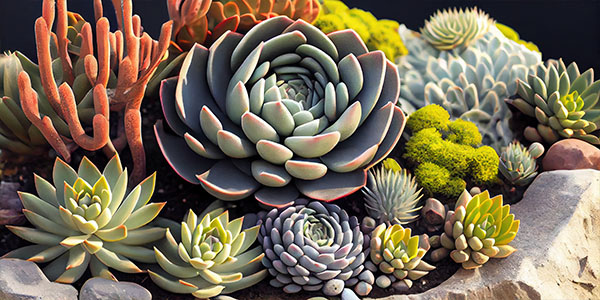
5. Add Your Xeriscape Plants
When picking out plants for your new xeriscaped yard or garden, choose low-water perennial plants native to your area. Use the USDA Plant Hardiness Zone Map to find plants most likely to grow and flourish in your area. And don’t forget your pre-determined zones: Oasis, Transition and Xeric. These zones will help you group plants that need the same amount of water, so you can efficiently water your yard using your chosen irrigation method.
If you’re looking to xeriscape on a budget, use plant cuttings instead of fully-grown plants. You can propagate succulents by cutting leaves from the original plant and planting them in your soil. It’ll take a few weeks for the plants to grow, but then you’ll have the lush drought tolerant garden you were looking for.

“Native plants are well adapted to the local climate, soil types and animals. This means they generally require less maintenance — such as watering, fertilizing or protecting from pests — compared to non-native plants. They also help to maintain the biodiversity of the region.”
Kane Miller, Founder, YardYum
Types of Xeriscape Plants
Typically, drought-tolerant plants have deep roots to reach water in the soil, waxy leaves or thick roots to hold water. While it’s best to choose plants that are native to your area, here are some common drought tolerant plants:
Oasis Zone | Transition Zone | Xeric Zone |
|---|---|---|
Barrenwort | Russian Sage | Sedum |
Lily of the Valley | Artemisia | Lavender |
Fringed Bleeding Heart | Fountain Grass | Lambs Ear |
Witch Hazel | Geranium | Aloe |
Daffodils | Trumpet Vine | New Zealand Tea Tree |
6. Maintaining Your Yard
Now that you know how to xeriscape your yard, it’s time to talk about maintenance.
- Water deeply and less often. This allows your roots to grow deeper and stronger. After your plants are fully grown, the goal is to water them about every two weeks. Be sure to water early in the morning to prevent evaporation.
- Keep a close eye on your irrigation system, especially if it is under mulch, to make sure there are no leaks and that the roots aren’t growing into the holes of the hose. If you see dry spots or pooling water, typically there is a leak.
- Prune your plants after the first year when they are getting too large, or if you see dead leaves.
- While weeding needs should be minimal, be sure to pick out weeds when you see them. Weed after watering or rain for easy removal.
- Replace your mulch every 1-2 years, usually in the spring.
- Mow your lawn so the grass is 3 inches tall.
Looking for More Ways to Make Your Home Green?
Outside of xeriscape landscaping, there are plenty of things you can do inside and outside of the home to conserve water and energy and live a more sustainable life.

“Replacing old appliances and plumbing fixtures like clothes washers, dishwashers, toilets, showerheads, faucet aerators and irrigation systems with WaterSense-labeled, high-efficiency equipment can save water and energy.”
Greg Fisher, Manager of Demand Planning, Denver Water


